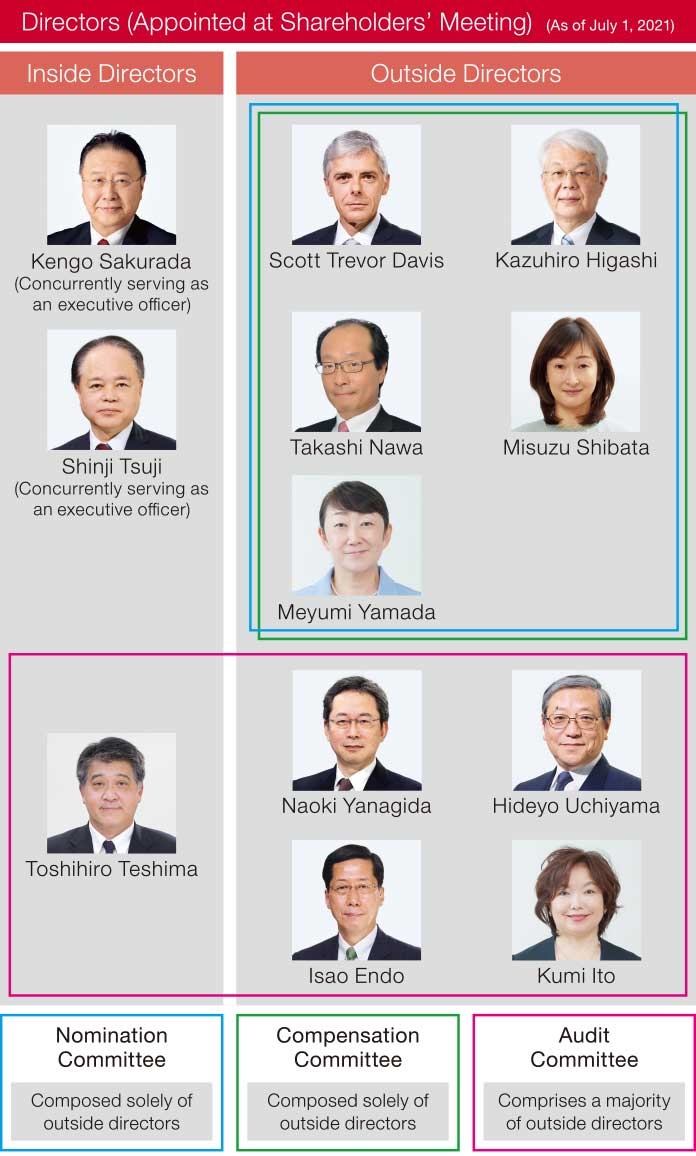Supervisory Framework
The Company elected to adopt a Company with Committees structure in June 2019 as part of efforts to strengthen corporate governance by separating management supervision from business execution, in order to reinforce the supervisory function of the Board of Directors and to accelerate business execution by delegating substantial authority to executive officers. The Company also established three committees: the Nomination Committee, the Audit Committee, and the Compensation Committee. This has put into place a governance system with improved transparency and fairness.
Board of Directors
The Board of Directors performs its duties as stipulated by law or the Articles of Incorporation, establishes important items for management defined in the Rules of Board of Directors, and serves a supervisory function overseeing the state of business execution. The chairman of the Board of Directors, who is appointed by the Board as stipulated in the Articles of Incorporation, also serves as a director and the Group CEO.
As of the conclusion of the 11th General Meeting of Shareholders, nine of the twelve directors are outside directors (a majority), consisting of eleven Japanese people and one non-Japanese person, of whom nine are men and three are women. The average length of service (including time served as an Audit & Supervisory Board member) is 4.1 years.
Nomination Committee
The Nomination Committee defines policy and standards for the appointment of directors and executive officers, determines the list of candidates, and is involved in the appointment of directors and executive officers at subsidiaries, depending on their business type and scale. In addition, the committee deliberates on the appointment and dismissal of the Group CEO based on a personal performance evaluation for the purpose of enhancing transparency and corporate governance.
The Nomination Committee consists of at least three directors, a majority of whom are from among the outside directors. The chair of the Nomination Committee is chosen from among the outside directors on the committee. As of July 2021, the committee comprises five outside directors.
Compensation Committee
The Compensation Committee determines the evaluation, compensation scheme, and compensation amounts of directors and executive officers, and is involved in deciding the compensation scheme of directors and executive officers at subsidiaries, depending on their business type and scale. In addition, the committee conducts a personal performance evaluation of the Group CEO to enhance transparency and objectivity in the compensation-deciding process, and to improve corporate governance.
The Compensation Committee consists of at least three directors, a majority of whom are from among the outside directors. The chair of the Compensation Committee is chosen from among the outside directors on the committee. As of July 2021, the committee comprises five outside directors.
Audit Committee
The Audit Committee audits—from a legal compliance and appropriateness perspective—the performance of duties by directors and executive officers, produces audit reports, and determines proposals regarding the appointment, dismissal, and non-reappointment of independent accounting auditors. It also exercises right of consent to decisions on auditor compensation and the like, formulates audit standards, basic policies for audits, and auditing plans, and conducts organization-wide audits.
The Audit Committee consists of at least three members selected from among directors who do not have any executive roles, and the majority of members are outside directors. In principle, the committee chair is an outside director, selected from among its members, and the committee has at least one full-time Audit Committee member and at least one Audit Committee member who has expert knowledge of finance and accounting. As of July 2021, there are five members on the committee, four of whom are outside directors.
